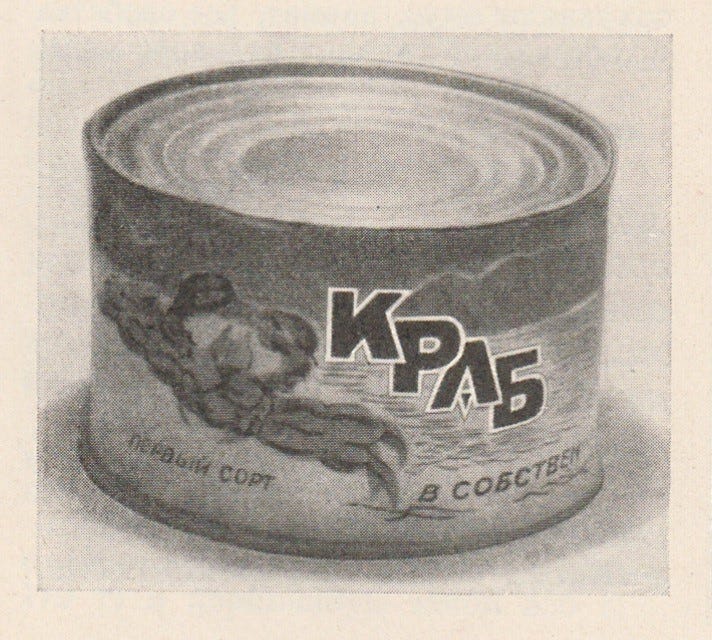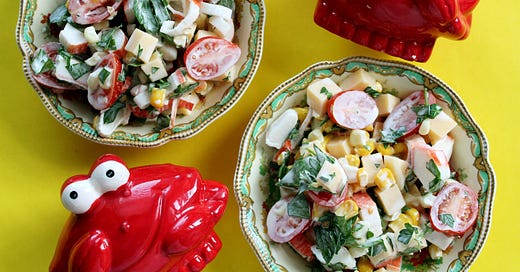Consider the crab stick. The chicken nugget of the sea. Made most commonly from Pollock, an abundant fleshy white fish, through a Japanese centuries-old preservation process called surimi. It is notably sweeter, denser and cheaper than its natural counterpart, making the distinction between real and fake crab hard to miss.
So if the host of my quarantine sushi making class was correct that it “crab sticks were invented for American sushi in the 1970s” (he was not), then why did I eat so many great crab stick based dishes in Ukraine?
To answer that we need to go back to Stalin’s desire win Soviet hearts through their stomachs. During the 1930s, while he was systematically starving millions of rural Ukrainians through a grain collectivization program, he sent the People’s Commissar of Food and Trade, Anastas Mikoyan, on a tour of US industrialized food production.
Mikoyan returned with a plethora of ideas on how to revolutionize both the Soviet food system and the domestic kitchen. One result of this trip was the USSR’s publication of The Book of Tasty and Healthy Food in 1939. Part cookbook, part patriotic guidebook, it blended a picture of food abundance with a smattering of replicable national dishes from around the Soviet republics. To that, it added refashioned American foods as well as newly created Soviet dishes based on what could most easily be mass produced. After the second printing in the mid-1950s, it had sold 2.5 million copies, putting it in roughly 5% of Soviet households.

The book includes a few recipes for dishes like crab in white wine and butter sauce. It highlights crab fishing and canning in the Kamchatka peninsula, due west of southern Alaska, noting world famous crabs weighting upwards of 4 - 7 pounds with leg spans reaching up to a yard long. Much like Soviet champagne and chocolates, crab becomes another way to prove that the capitalist West did not have a monopoly on luxury.
A decade after the book’s second printing, a Japanese scientist discovers a way to lengthen the shelf life of surimi by preserving it with sugar, making it possible to export. then in 1966, the USSR and Japan sign a trade agreement including food products.
Within a few years fishers of the eastern Soviet Union rise to the growing demand for Pollock in Japan and learn to make their own surimi on the boat to maximize freshness and fetch a higher purchase price. But it will take another decade before imitation crab rides on the wave of glasnost into the Soviet home kitchen.
When it does arrive in the mid-1980s, home cooks make brilliant use of what’s available. In my favorite case, letting vibrant home-grown tomatoes elevate processed foods like imitation crab sticks, processed cheese and canned corn.
While that list of ingredients might sound dated in an era of wild caught fish, artisanal cheese and farmer’s market corn right out of the recreated field of dreams (what are they gonna get if they auction that corn as an NFT?!), the rest of us are happily relying on innovative techniques like flash freezing to get sweet corn easy enough to thaw and throw into a pre-cooked Pollock salad parading around as a shellfish delicacy.
Нижніст - crab & corn salad
In Ukrainian, this dish is called Nizhnist or “Tenderness” salad. This doesn’t translate well, but it means something like comfort food salad and can also be made with chicken. Many of the Ukrainian language recipes I found online include hard boiled eggs, green onions and either fresh cucumbers or pickles, making the dish decidedly more savory. Here the focus is on the sweetness of corn and cherry tomatoes which highlights the sweetness of imitation crab. To keep things balanced, make sure to add plenty of salt.
what you need
1 pint cherry tomatoes, halved ◾ 8 ounces of imitation crab sticks, chopped ◾ 4 ounces hard, mild cheese cubed (try edam, unsmoked gouda or gruyère) ◾ 8 ounces corn, fresh or frozen and thawed ◾ 1 lemon ◾ 1 handful of chopped parsley ◾ 1/4 cup unsweetened mayonnaise like Duke’s ◾ 2-3 teaspoons of kosher salt
what to do
Prepare ingredients, chopping to make everything relatively equitable in size. Then, in a medium bowl combine tomatoes, crab sticks, cheese, and corn. Sprinkle the lemon juice, parsley, and salt over the ingredients. Fold in mayonnaise until the salad is well coated. The dressing should be very thin like a vinaigrette, not thick like an egg salad. Serve cold.
Reading - Post-Soul Nation by Nelson George (2005)
Listening - The Book of Tasty and Healthy Food by 99 Percent Invisible (2021)
Watching - The Green Knight by David Lowery (2021)
Smelling - Falling Into the Sea by Imaginary Authors (2012)





